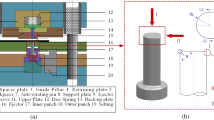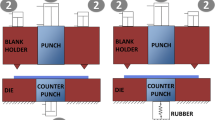Abstract
Fine blanking is an economical process to manufacture components with a high sheared edge quality. Fine blanking of high-strength steels leads to an increase of the wear of fine blanking punches and deteriorates the economical efficiency of this process. In preliminary work lateral surfaces of cylindrical punches made of different hardened steels industrially used for tool manufacturing were deep rolled. Under proper process parameters a reduction of surface roughness, a hardness increase as well as an induction of compressive residual stresses in the surface layer were achieved. Therefore, deep rolling has a potential to improve the wear resistance of fine blanking punches. In order to improve the quality of the sheared edge of a workpiece, fine blanking punches must have a round fillet on the cutting edge. Filleting through plastic deformation can improve the wear resistance of this most loaded region of the fine blanking punch. In order to perform the filleting of the cutting edge through plastic deformation and to induce strain hardening and compressive residual stresses into the edge region a novel profiled deep rolling tool is developed in this work. Furthermore, the technical feasibility of the edge deep rolling with regard to the processing of fine blanking punches is assessed for the first time. The approach is based on a numerical modeling and experimental investigation of edge deep rolling.








Similar content being viewed by others
References
Luo SY (1999) Effect of the geometry and the surface treatment of punching tools on the tool life and wear conditions in the piercing of thick steel plate. J Mater Proc Tech 88:122–133. doi:10.1016/S0924-0136(98)00375-6
Sergejev F, Peetsalu P, Sivitski A, Saarna M, Adoberga E (2011) Surface fatigue and wear of PVD coated punches during fine blanking operation. Eng Fail Anal 18:1689–1697. doi:10.1016/j.engfailanal.2011.02.011
Sonsino CM (2007) Light-weight design chances using high-strength steels. Mat-wiss u Werkstofftech 38:9–22. doi:10.1002/mawe.200600090
Klocke F (2009) Manufacturing processes 4, forming. Springer, Berlin
Klocke F, Sweeney K, Raedt HW (2001) Improved tool design for fine blanking through the application of numerical modeling techniques. J Mater Proc Tech 115:70–75. doi:10.1016/S0924-0136(01)00771-3
Schulze V, Schwing JK (2006) Modern mechanical surface treatment. States, stability, effects. Wiley-VCH, Weinheim
Altenberger I (2005) Deep rolling-the past, the present and the future. In: Schulze V, Niku-Lari A (eds) Proceedings of 9th International Conference on Shot Peening ICSP-9, Paris, France
Niku-Lari A (1987) Advances in surface treatments. Pergamon Press, Oxford
Meyer D, Kruse D, Bobe A, Goch G, Brinksmeier E (2010) Nondestructive characterization of the surface integrity of cold surface hardened components. Prod Eng Res Devel 5:443–449. doi:10.1007/s11740-010-0228-3
Galzy F, Michaud H, Sprauel J M (2005) Approach of residual stress generated by deep rolling application to the reinforcement of the fatigue resistance of crankshafts. Mater Sci Forum 490-491:384–389. doi:10.4028/www.scientific.net/MSF.490-491.384
Abrão AM, Denkena B, Breidenstein B, Mörke T (2014) Surface and subsurface alterations induced by deep rolling of hardened AISI 1060 steel. Prod Eng Res Devel 8:551–558. doi:10.1007/s11740-014-0539-x
Klocke F, Shirobokov A, Mattfeld P, Feuerhack A (2014) Festwalzen von Feinschneidstempeln (in german) 10:660–665. wt-online
Hoffmann H (2012) Handbuch Umformen (in german) Hanser, Mnchen
Picas I, Hernndez R, Casellas D, Valls I (2010) Strategies to increase the tool performance in punching operations of UHSS. In: Proceedings of IDDRG 2010 Graz, Austria, pp 325–334
Röttger K (2003) Walzen hartgedrehter Oberflächen (in german). RWTH Aachen University, Dissertation
Mader S (2006) Festwalzen von Fan- und Verdichterschaufeln (in german). RWTH Aachen University, Dissertation
Manouchehrifar A, Alasvand K (2009) Finite element simulation of deep rolling and evaluate the influence of parameters on residual stress. In: Tsuomu K (ed) Recent Researches in Applied Mechanics. WSEAS Press, Athens, pp 121–127
Bäcker V, Klocke F, et al (2010) Analysis of the deep rolling process on turbine blades using the FEM/BEM-coupling. IOP Conf Ser: Mater Sci Eng 10:012134. doi:10.1088/1757-899X/10/1/012134
Balland P, Tabourot L, Degre F, Moreau V (2013) An investigation of the mechanics of roller burnishing through finite element simulation and experiments. Int J Mach Tools Manuf 65:29–36. doi:10.1016/j.ijmachtools.2012.09.002
Perenda J, Trajkovski J (2015) Residual stresses after deep rolling of a torsion bar made from high strength steel. J Mater Proc Tech 218:89–98. doi:10.1016/j.jmatprotec.2014.11.042
Trauth D, Klocke F, Mattfeld P, Klink A (2013) Time-efficient prediction of the surface layer state after deep rolling using similarity mechanics approach. Procedia CIRP 9:29–34. doi:10.1016/j.procir.2013.06.163
Jung DW, Yang DY (1998) Step-wise combined implicitexplicit finite-element simulation of autobody stamping processes. J Mater Proc Tech 83:245–260. doi:10.1016/S0924-0136(98)00059-4
Noels L, Stainier L, Ponthot JP (2004) Combined implicit/explicit time-integration algorithms for the numerical simulation of sheet metal forming. J Comput Appl Math 168:331–339. doi:10.1016/j.cam.2003.12.004
Achmus C, Jung U, Kaiser B, Wohlfahrt H (1997) FEM-simulation des festwalzens von kurbelwellen (in german). Konstruktion 10:31–34
Systemes Dassault (2014) Abaqus Analysis User’s Guide: Prescribed Conditions, Constraints & Interaltions
Acknowledgments
The authors would like to thank the Federal Ministry for Economic Affairs and Energy within the Central Innovation Program SME Initiative (ZIM) for partly funding this research work. Further, we express our gratitude to the following industrial partners for their support: Karl Scharrenbroich GmbH & Co.KG, Ecoroll AG Werkzeugtechnik.
Author information
Authors and Affiliations
Corresponding author
Rights and permissions
About this article
Cite this article
Klocke, F., Shirobokov, A., Trauth, D. et al. Deep rolling of fine blanking punch edges. Int J Mater Form 9, 489–498 (2016). https://doi.org/10.1007/s12289-015-1235-x
Received:
Accepted:
Published:
Issue Date:
DOI: https://doi.org/10.1007/s12289-015-1235-x




